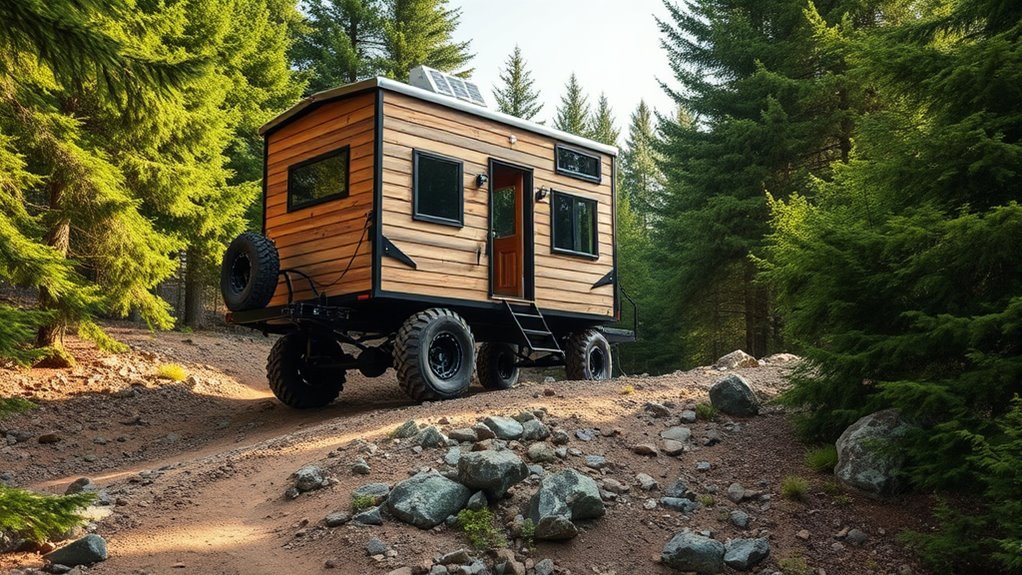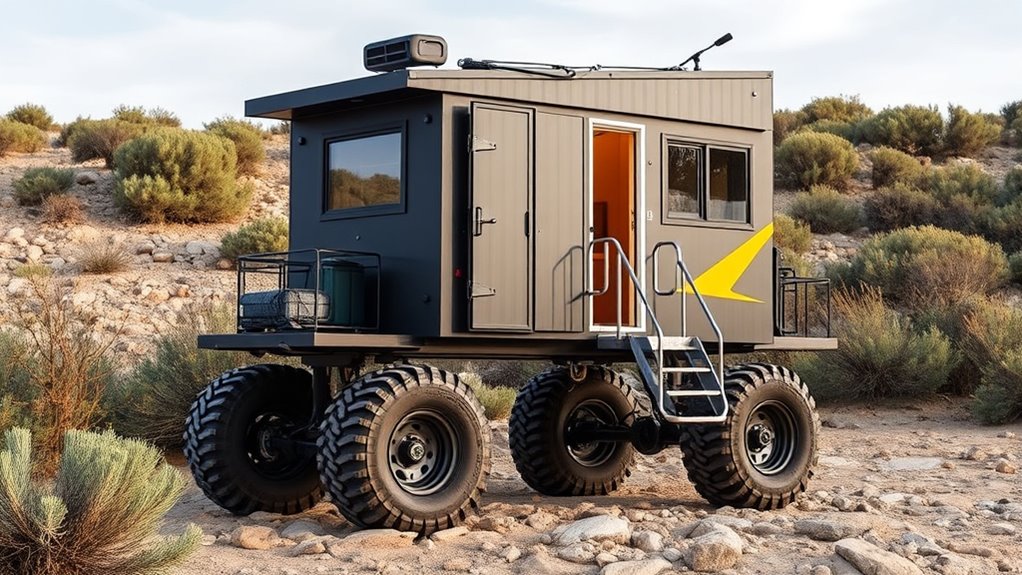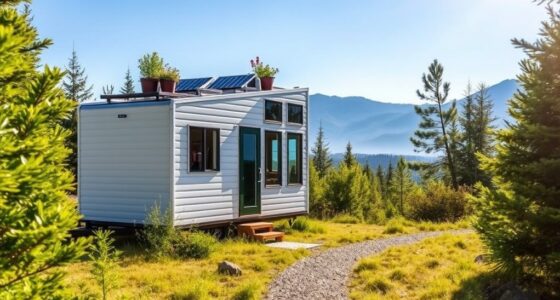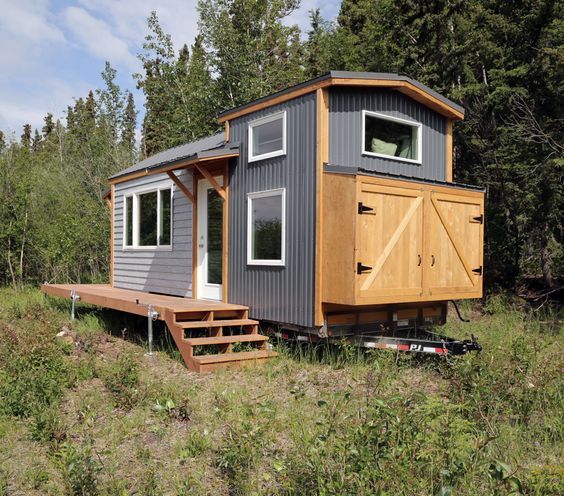To make your tiny home off-road ready, focus on durable, impact-resistant materials and corrosion-proof finishes that withstand tough conditions. Incorporate lightweight structures with reinforced chassis, rugged tires, and enhanced suspension for stability. Use solar panels for self-sufficient energy, and optimize interior space with multi-purpose furniture and smart storage. Improve ventilation with large windows and vents for comfort. Keep exploring to discover detailed features that turn your tiny home into a true off-road adventure vessel.
Key Takeaways
- Use lightweight, impact-resistant, and corrosion-proof materials to withstand rugged outdoor environments.
- Incorporate high-clearance suspension systems and durable tires for off-road mobility.
- Design with reinforced chassis and protective bumpers to handle rough terrains safely.
- Install flexible solar panels and efficient power systems for off-grid energy independence.
- Maximize space with smart storage, large windows, and ventilation for comfort in remote locations.

If you’re dreaming of a tiny home that can go anywhere, off-road design offers the perfect solution. These homes are built to handle rough terrains, giving you the freedom to explore remote locations without sacrificing comfort or sustainability. One of the standout features of off-road tiny homes is solar integration. By installing solar panels on the roof, you harness the sun’s energy to power your appliances, lights, and even water heaters. This setup reduces your reliance on external power sources and makes your home more self-sufficient, especially when you’re miles away from electrical hookups. With portable or flexible solar panels, you can optimize sun exposure no matter the direction your tiny home faces. This eco-friendly approach not only saves you money on energy costs but also aligns with the minimalist, sustainable lifestyle many tiny home enthusiasts seek.
Off-road tiny homes use solar power to stay self-sufficient in remote locations.
The interior layout of an off-road tiny home is equally important. It needs to maximize space while maintaining functionality and comfort. You’ll want to prioritize multi-purpose furniture, such as fold-away beds, convertible tables, and storage solutions integrated into walls and stairs. This kind of interior design ensures you use every inch efficiently, making your home feel spacious despite its small footprint. Additionally, durable materials are essential for the interior, as off-road environments can be rough on furnishings. Lightweight, impact-resistant surfaces and corrosion-proof finishes help your tiny home withstand the rigors of outdoor adventures. Smart storage options, like under-bed compartments and wall-mounted shelves, prevent clutter and keep essentials within reach. Incorporating durable materials is crucial for longevity, especially in rugged environments.
Lighting and ventilation are also vital elements of the interior layout, especially when you’re off-grid. Large windows, skylights, and well-placed vents improve airflow and natural light, creating a bright, airy atmosphere inside. This reduces the need for electrical lighting during the day and helps regulate temperature naturally. For heating and cooling, consider insulation and energy-efficient appliances to maintain comfort without draining your battery or water supply. The goal is to create an interior that’s both practical and relaxing, allowing you to enjoy the serenity of nature without feeling cramped or disconnected.
Ultimately, off-road design marries rugged durability with smart, sustainable features. Solar integration ensures you stay powered up in remote locations, while a thoughtfully planned interior layout maximizes your space and comfort. Together, these elements enable you to venture off the beaten path confidently, knowing your tiny home is equipped to handle the challenges of outdoor living while offering a cozy, efficient retreat wherever your adventures take you.
Frequently Asked Questions
How Do Off-Road Designs Impact Tiny Home Maintenance?
Off-road designs can make tiny home maintenance more manageable by enhancing utility flexibility, allowing you to access critical components easily for repairs. You’ll find it easier to maintain the home’s systems without worrying about aesthetic integration, as off-road features are built for durability and function. This design reduces the wear and tear caused by rough terrain, meaning less frequent repairs and more time enjoying your tiny home rather than fixing it.
What Legal Restrictions Apply to Off-Road Tiny Homes?
Like steering a maze, you must understand legal restrictions for off-road tiny homes. Zoning regulations and parking ordinances vary widely by location, affecting where you can place your home. Some areas ban or limit off-grid living, while others have specific rules for mobile dwellings. Always research local laws before setting up, so you stay compliant and avoid potential fines or removal. Staying informed helps you enjoy your off-road tiny home hassle-free.
How Do Off-Road Features Affect Tiny Home Resale Value?
Off-road features can boost your tiny home’s resale value by enhancing its off-road aesthetics, making it more appealing to adventure seekers and outdoor enthusiasts. These features demonstrate durability and ruggedness, attracting a niche resale market. However, over-customization might limit potential buyers. Balance off-road capabilities with universal appeal to maximize resale value, ensuring your tiny home stands out in the market without alienating mainstream buyers.
Can Off-Road Modifications Be Customized for Different Terrains?
Yes, off-road modifications can be tailored for different terrains. You can enhance your tiny home’s terrain adaptability by choosing specific suspension systems, tires, and clearance levels suited to your environment. Customization options include adding reinforced wheels for rocky terrains or lightweight features for sandy areas. By selecting the right features, you guarantee your tiny home performs well across diverse terrains, providing greater flexibility and comfort wherever you go.
What Safety Considerations Are Unique to Off-Road Tiny Homes?
Imagine your tiny home as a fortress amid nature’s wild stage. You must prioritize wildfire prevention, ensuring fire-safe materials and clear escape routes. Be prepared for wildlife encounters by securing food and trash to avoid attracting animals. Unique safety concerns include uneven terrain stability, off-road vehicle safety, and emergency access. Staying vigilant and proactive helps protect you, your home, and the environment in these adventurous settings.
Conclusion
Think of your tiny home as a rugged explorer venturing into uncharted territory. With off-road design features, you’re equipping it to conquer rough terrains and unpredictable conditions, just like a seasoned adventurer facing the wild. Embrace these features as your home’s sturdy armor, ensuring it’s ready for any journey. When you choose off-road design, you’re not just building a tiny home—you’re forging a resilient vessel ready to embrace the wild, wherever it may lead.








